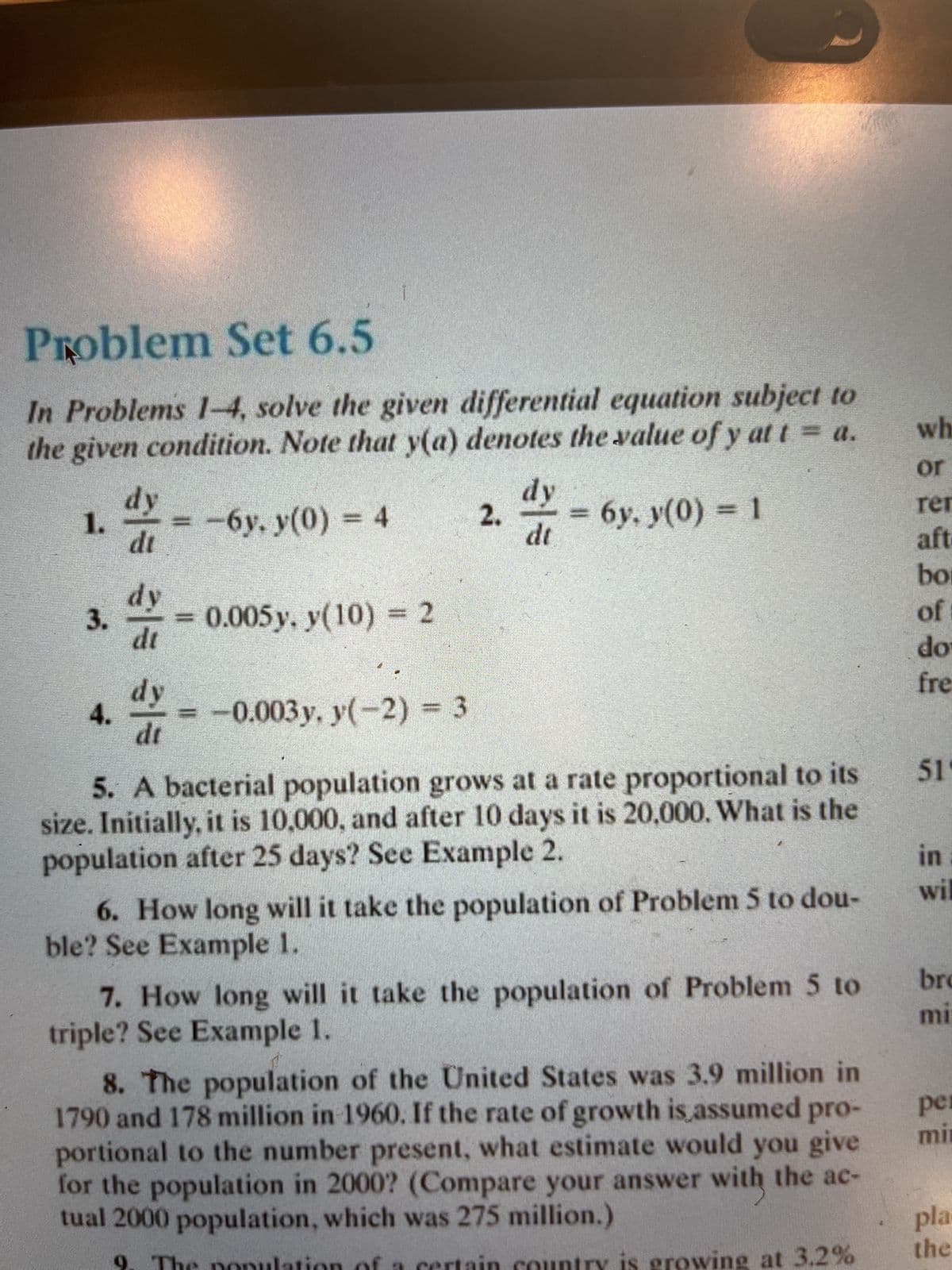Calculus: Early Transcendentals
8th Edition
ISBN:9781285741550
Author:James Stewart
Publisher:James Stewart
Chapter1: Functions And Models
Section: Chapter Questions
Problem 1RCC: (a) What is a function? What are its domain and range? (b) What is the graph of a function? (c) How...
Related questions
Question
Help with 1 please!
I don't know how to approach these questions and the textbook is really confusing me!

Transcribed Image Text:Problem Set 6.5
In Problems 1-4, solve the given differential equation subject to
the given condition. Note that y(a) denotes the value of y at t = a.
-6y. y(0) = 4
1.
3.
4.
5 31 313
dy
di
dy
dt
dy
dt
0.005 y, y(10) = 2
-0.003 y. y(-2) = 3
2.
dy
dt
=
6y, y(0) = 1
5. A bacterial population grows at a rate proportional to its
size. Initially, it is 10,000, and after 10 days it is 20,000. What is the
population after 25 days? See Example 2.
6. How long will it take the population of Problem 5 to dou-
ble? See Example 1.
7. How long will it take the population of Problem 5 to
triple? See Example 1.
8. The population of the United States was 3.9 million in
1790 and 178 million in 1960. If the rate of growth is assumed pro-
portional to the number present, what estimate would you give
for the population in 2000? (Compare your answer with the ac-
tual 2000 population, which was 275 million.)
at 3.2%
wh
or
rer
aft
bo
of
do
fre
51
in
wil
bro
mi
per
min
pla
the
Expert Solution
This question has been solved!
Explore an expertly crafted, step-by-step solution for a thorough understanding of key concepts.
Step by step
Solved in 2 steps

Recommended textbooks for you

Calculus: Early Transcendentals
Calculus
ISBN:
9781285741550
Author:
James Stewart
Publisher:
Cengage Learning

Thomas' Calculus (14th Edition)
Calculus
ISBN:
9780134438986
Author:
Joel R. Hass, Christopher E. Heil, Maurice D. Weir
Publisher:
PEARSON

Calculus: Early Transcendentals (3rd Edition)
Calculus
ISBN:
9780134763644
Author:
William L. Briggs, Lyle Cochran, Bernard Gillett, Eric Schulz
Publisher:
PEARSON

Calculus: Early Transcendentals
Calculus
ISBN:
9781285741550
Author:
James Stewart
Publisher:
Cengage Learning

Thomas' Calculus (14th Edition)
Calculus
ISBN:
9780134438986
Author:
Joel R. Hass, Christopher E. Heil, Maurice D. Weir
Publisher:
PEARSON

Calculus: Early Transcendentals (3rd Edition)
Calculus
ISBN:
9780134763644
Author:
William L. Briggs, Lyle Cochran, Bernard Gillett, Eric Schulz
Publisher:
PEARSON

Calculus: Early Transcendentals
Calculus
ISBN:
9781319050740
Author:
Jon Rogawski, Colin Adams, Robert Franzosa
Publisher:
W. H. Freeman


Calculus: Early Transcendental Functions
Calculus
ISBN:
9781337552516
Author:
Ron Larson, Bruce H. Edwards
Publisher:
Cengage Learning